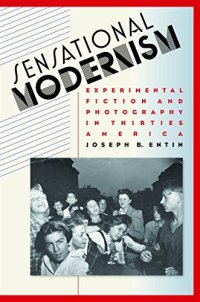
Ebook: Sensational modernism : experimental fiction and photography in thirties America
Author: Weegee, Siskind Aaron, Entin Joseph B
- Tags: American fiction -- 20th century -- History and criticism. Experimental fiction American -- History and criticism. Art and literature -- United States -- History -- 20th century. Documentary photography -- United States -- History -- 20th century. Mass media and art -- United States. Modernism (Literature) -- United States. Visual perception in literature.
- Series: Cultural studies of the United States
- Year: 2007
- Publisher: The University of North Carolina Press
- City: Chapel Hill, United States., Array
- Edition: 1
- Language: English
- epub
Challenging the conventional wisdom that the 1930s were dominated by literary and photographic realism, Sensational Modernism uncovers a rich vein of experimental work by politically progressive artists. Examining images by photographers such as Weegee and Aaron Siskind and fiction by writers such as William Carlos Williams, Richard Wright, Tillie Olsen, and Pietro di Donato, Joseph Entin argues that these artists drew attention to the country's most vulnerable residents by using what he calls an "aesthetic of astonishment," focused on startling, graphic images of pain, injury, and prejudice.
Traditional portrayals of the poor depicted stoic, passive figures of sentimental suffering or degraded but potentially threatening figures in need of supervision. Sensational modernists sought to shock middle-class audiences into new ways of seeing the nation's impoverished and outcast populations. The striking images these artists created, often taking the form of contorted or disfigured bodies drawn from the realm of the tabloids, pulp magazines, and cinema, represented a bold, experimental form of social aesthetics. Entin argues that these artists created a willfully unorthodox brand of vernacular modernism in which formal avant-garde innovations were used to delineate the conditions, contradictions, and pressures of life on the nation's fringes.
Traditional portrayals of the poor depicted stoic, passive figures of sentimental suffering or degraded but potentially threatening figures in need of supervision. Sensational modernists sought to shock middle-class audiences into new ways of seeing the nation's impoverished and outcast populations. The striking images these artists created, often taking the form of contorted or disfigured bodies drawn from the realm of the tabloids, pulp magazines, and cinema, represented a bold, experimental form of social aesthetics. Entin argues that these artists created a willfully unorthodox brand of vernacular modernism in which formal avant-garde innovations were used to delineate the conditions, contradictions, and pressures of life on the nation's fringes.
Download the book Sensational modernism : experimental fiction and photography in thirties America for free or read online
Continue reading on any device:

Last viewed books
Related books
{related-news}
Comments (0)